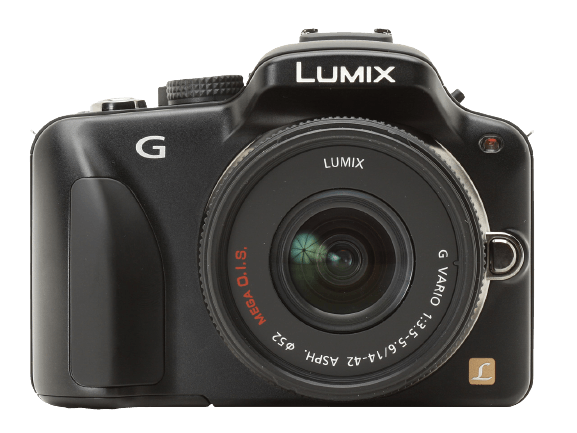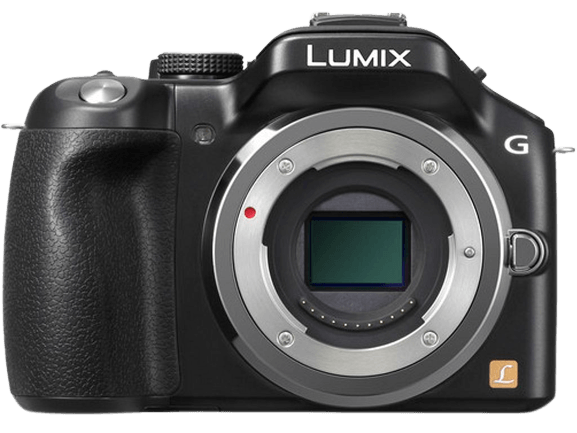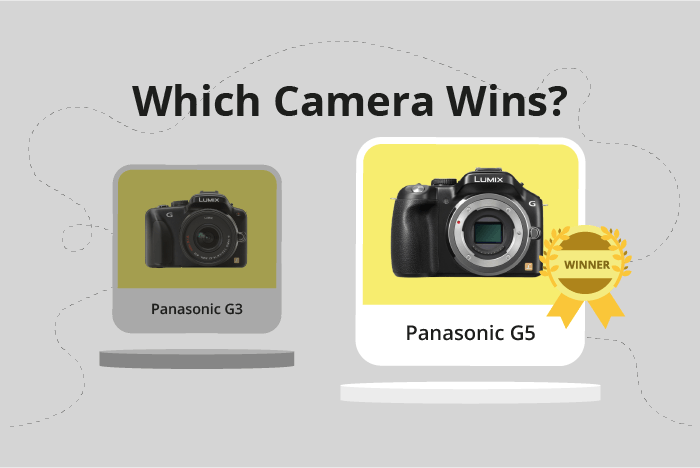Panasonic Lumix DMC G3 vs Lumix DMC G5 Comparison
Panasonic Lumix DMC G3

Panasonic Lumix DMC G5

The Panasonic Lumix DMC G5 takes the lead with a score of 47/100, compared to the Panasonic Lumix DMC G3‘s 42/100. Both cameras share similarities as mirrorless cameras, released in 2011 and 2012, with launch prices of $599 and $650, respectively.
The G5 outshines the G3 with a higher score, reflecting its better performance and features. However, the G3 has its advantages, being lighter at 336g compared to the G5’s 396g and slightly smaller in size (115 x 84 x 47mm) than the G5 (120 x 83 x 71mm).
Taking all points into consideration, the Panasonic Lumix DMC G5 is the superior choice due to its higher score, but the G3 may be preferred by those seeking a lighter and more compact camera.
Panasonic Lumix DMC G3 vs Lumix DMC G5 Overview and Optics
The Panasonic Lumix DMC G5 emerges as the winner in the optics comparison, scoring 46 out of 100, while the Panasonic Lumix DMC G3 scores 42. Both cameras share some common specifications, including 16-megapixel resolution, Micro Four Thirds sensor size, Micro 4/3 lens mount, and the absence of image stabilization.
The G5 outperforms the G3 in several aspects. It has a slightly higher megapixel count at 16.05, which contributes to better image resolution. The G5 also has a faster shooting speed of 6 frames per second, compared to the G3’s 4 frames per second, allowing for better capture of fast-moving subjects. The G5’s CMOS sensor and Venus Engine VII FHD processor give it a higher DXOMARK score of 61, compared to the G3’s Live MOS sensor and Venus Engine FHD processor with a DXOMARK score of 56. This difference results in improved image quality, color depth, and low-light performance for the G5.
On the other hand, the G3 does not have any significant advantages over the G5 in terms of optics. Both cameras have the same sensor size and lens mount, as well as the absence of image stabilization. Therefore, it is clear that the G5 is the better camera in this comparison.
Taking into account the differences in specifications and performance, the Panasonic Lumix DMC G5 is the superior choice for those seeking better optics. With its marginally higher megapixel count, faster shooting speed, and improved sensor and processor, the G5 delivers better image quality and performance than the G3.
Panasonic Lumix DMC G3 vs Lumix DMC G5 Video Performance
The Panasonic Lumix DMC G3 and the Panasonic Lumix DMC G5 both have a video score of 56/100, indicating that they have similar video capabilities. Both cameras offer Full HD video resolution with maximum dimensions of 1920 x 1080 and a maximum frame rate of 60fps. Additionally, neither camera has built-in time-lapse functionality.
Despite their identical scores, there are differences in their video capabilities. The G5 has an improved video codec, which provides better video compression and quality. This means that the G5’s videos will have less noise and artifacts, resulting in clearer and more detailed footage. Furthermore, the G5 has a better autofocus system for video, allowing for smoother and more accurate focus transitions while recording. These improvements make the G5 the better option for those looking for superior video quality and performance.
On the other hand, the G3 has a slightly smaller and lighter body, making it more portable and easier to carry around. This could be an advantage for those who prioritize portability over video quality. However, this advantage is minor compared to the improvements offered by the G5.
Taking into account the differences in video quality and performance, the Panasonic Lumix DMC G5 is the superior choice for those seeking better video capabilities. The G3 may be more portable, but its video performance is not as strong as the G5’s. Therefore, for users who prioritize video quality and performance, the Panasonic Lumix DMC G5 is the recommended option.
Panasonic Lumix DMC G3 vs Lumix DMC G5 Features and Benefits
The Panasonic Lumix DMC G5 wins in the features category with a score of 54/100, while the Panasonic Lumix DMC G3 trails behind with a score of 49/100. Both cameras share several common specifications, including a 3-inch screen size, touchscreen capabilities, flip screen, and the absence of GPS, WiFi, and Bluetooth.
The G5 surpasses the G3 with a higher screen resolution of 920,000 dots, compared to the G3’s 460,000 dots. This higher resolution allows for better image preview and easier menu navigation on the G5, giving it an edge over the G3 in terms of display quality.
Although the G3 comes up short in screen resolution, it is not entirely worse than the G5. Both cameras have the same screen size, touchscreen, and flip screen features. The absence of GPS, WiFi, and Bluetooth in both models signifies that neither camera excels in connectivity options.
Upon examining each point, it is evident that the G5’s higher screen resolution gives it an advantage over the G3 in display quality. However, the G3 is on par with the G5 in other aspects, such as screen size and the presence of a touchscreen and flip screen. The lack of connectivity options in both cameras is a notable drawback.
Taking all factors into account, the Panasonic Lumix DMC G5 emerges as the better camera in terms of features, primarily due to its higher screen resolution. Nonetheless, the Panasonic Lumix DMC G3 remains a viable option for those who prioritize other aspects beyond display quality.
Panasonic Lumix DMC G3 vs Lumix DMC G5 Storage and Battery
The Panasonic Lumix DMC G5 outperforms the DMC G3 in storage and battery with a score of 21/100 compared to the G3’s 16/100. Both cameras share common specifications, including a single memory card slot and compatibility with SD, SDHC, and SDXC memory cards. Neither camera offers USB charging.
The DMC G5’s advantage lies in its battery life, providing 320 shots per charge, while the DMC G3 only delivers 270 shots. This difference makes the G5 more suitable for extended shooting sessions. The G5 uses a DMW-BLC12 battery, while the G3 utilizes a DMW-BLD10 battery type.
Despite the G3’s lower score, it doesn’t offer any advantages over the G5 in storage and battery. Therefore, the Panasonic Lumix DMC G5 is the better choice for photographers prioritizing longer battery life and reliable storage options.
Panasonic Lumix DMC G3 vs Lumix DMC G5 – Our Verdict
Are you still undecided about which camera is right for you? Have a look at these popular comparisons that feature the Panasonic Lumix DMC G3 or the Panasonic Lumix DMC G5:

